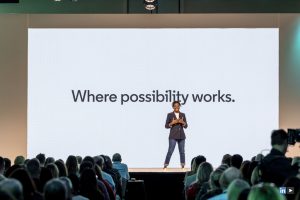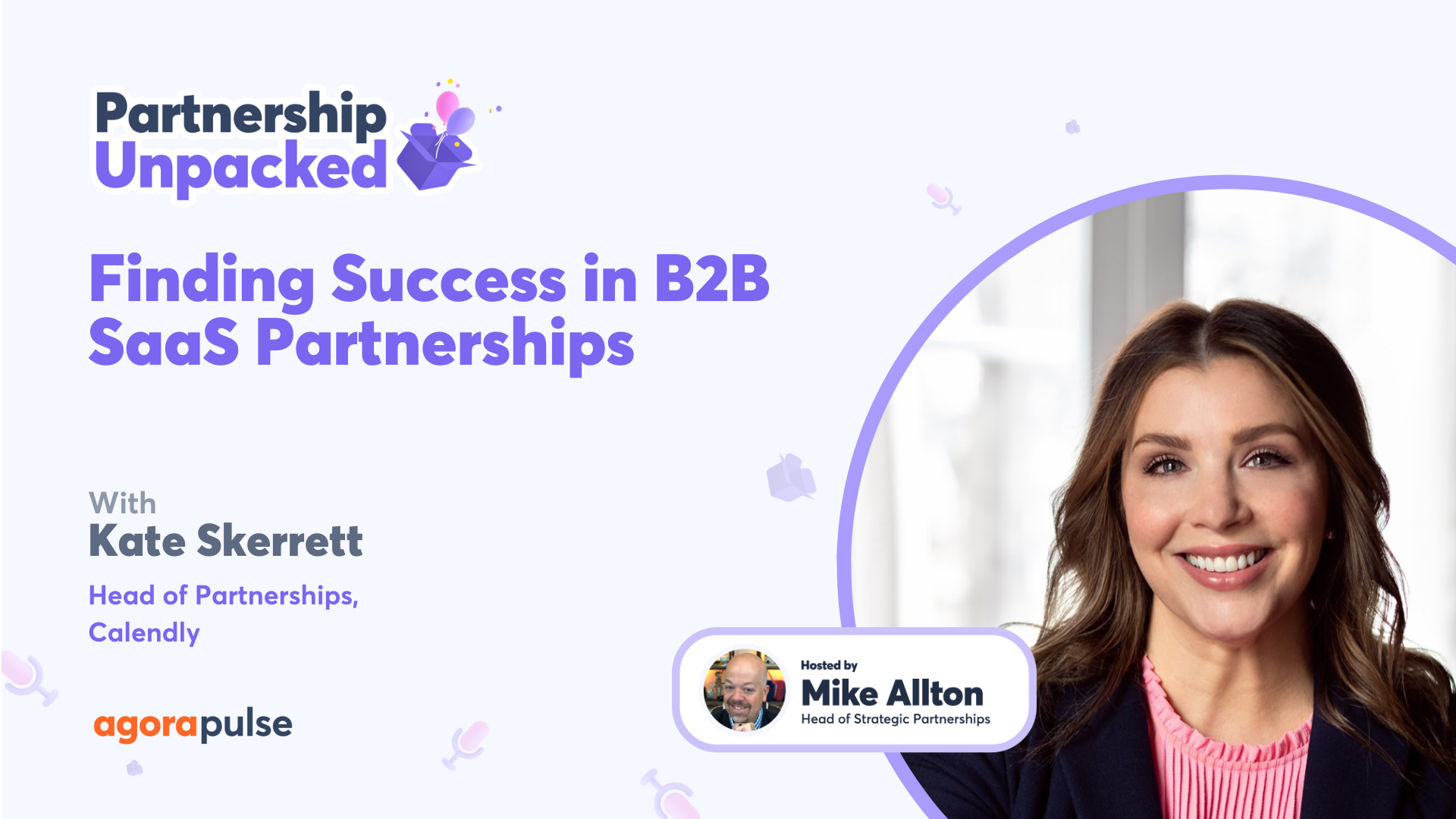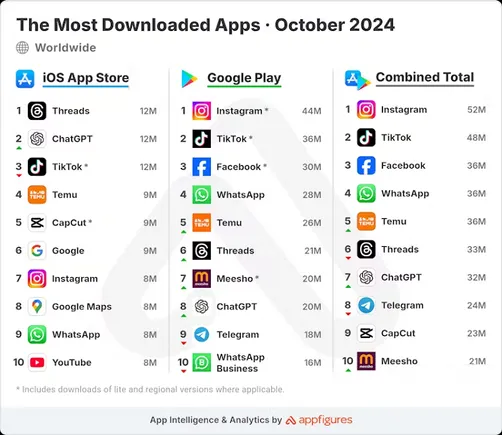One of the key tenets of our podcast here is the fact that there are a lot of different kinds of partnerships out there. Affiliates, influencers, tech integrations… and of course sales and marketing.
Which means one of the challenges facing B2B businesses is knowing which kind or kinds of partnerships to pursue.
Wouldn’t it be great to learn how other B2B SaaS companies are leveraging partnerships today?
That’s what we’re covering in today’s episode of Partnership Unpacked.
Welcome back to Partnership Unpacked, where I selfishly use this time to pick the brains of experts at strategic partnerships, channel programs, affiliates, influencer marketing, and relationship building… oh, and you get to learn too! Subscribe to learn how you can amplify your growth strategy – with a solid takeaway every episode from partnership experts in the industry.
Those of you who have been in marketing for a while know that one of the most effective kinds of content you can create for middle and bottom of funnel customers is case studies. People like to read about how other people are finding success with our products, right? It helps them relate and visualize.
Along the same lines, while we will continue to have subject matter experts here on the show, I also want to invite more partnership leaders, particularly at B2B SaaS companies like Agorapulse, to hear first-hand from them what’s working, what isn’t, and where they’re finding success.
That’s exactly why Kate Skerrett is joining us today.
Kate is the Head of Partnerships for Calendly, a powerful yet simple automated scheduling platform that we love here at Agorapulse and I use every day for scheduling podcast guests and partnership meetings. Kate is formerly of Deel and GlassDoor and is passionate about creatively finding new revenue streams through partnerships.
One of the key tenets of our podcast here is the fact that there are a lot of different kinds of partnerships out there. Affiliates, influencers, tech integrations… and of course sales and marketing.
Which means one of the challenges facing B2B businesses is knowing which kind or kinds of partnerships to pursue.
Wouldn’t it be great to learn how other B2B SaaS companies are leveraging partnerships today?
That’s what Kate Skerrett is here to help us with.
Kate is the Head of Partnerships for Calendly, a powerful yet simple automated scheduling platform that we love here at Agorapulse and I use every day for scheduling podcast guests and partnership meetings. Kate is formerly of Deel and GlassDoor and is passionate about creatively finding new revenue streams through partnerships.
Partnership Unpacked host Mike Allton talked to Kate Skerrett about:
♉️Successful B2B SaaS company partnership options
♉️What makes for a great B2B partner
♉️Tools and tactics for B2B partnership success
Subscribe to the show calendar: agorapulse.com/calendar
Learn more about Kate Skerrett
Resources & Brands mentioned in this episode
Full Notes & Transcript:
(Lightly edited)
Mike Alton: [00:00:00] One of the key tenants of our podcast here is the fact that there are a lot of different kinds of partnerships out there, affiliates, influencers, tech integrations, and of course, sales and marketing, which means one of the challenges facing B2B businesses is knowing which kind or kinds of partnerships Wouldn’t it be great to learn how other B2B SaaS companies are leveraging partnerships today?
Well, that’s what we’re covering in today’s episode of Partnership Unpacked.
This is Partnership Unpacked, your go to guide to growing your business . Through partnerships quickly. I’m your host, Mike Alton, and each episode unpacks the winning strategies and latest trends from influencer marketing to brand partnerships and ideas that you can apply to your own business to grow exponentially.
And now the rest of today’s episode.[00:01:00]
Welcome back to Partnership Unpacked, where I selfishly use this time to pick the brains of experts at strategic partnerships, channel programs, affiliates, influencer marketing, and relationship building. You get to learn to subscribe to learn how you can amplify your growth strategy with a solid takeaway every episode from partnership experts in the industry.
And those of you who’ve been in marketing for a while know that one of the most effective kinds of content you can create for middle and bottom of funnel customers. is case studies. People like to read about how other people are finding success with our products, right? It helps them relate and visualize.
Well, along the same lines, while we continue to have subject matter experts here on the show, I also want to invite more partnership leaders, particularly at B2B SaaS companies like Agorapulse, to hear firsthand from them what’s working, what isn’t. And where they’re finding success. And that’s exactly why Kate Skerrett is joining us today.
Kate is the head of partnerships for Calendly, a powerful yet simple automated scheduling platform that we love here at [00:02:00] Agorapulse. And I use every day for scheduling podcast guests and partnership marketing meetings and Kate’s formerly of Deal and Glassdoor and is passionate about creatively finding new revenue streams through partnerships.
Hey, Kate, welcome to the show.
Kate Skerrett: Hi there. Thank you for having me.
Mike Alton: Yeah, it’s great to have you. I know. I was gonna say this before we even started. You went to OU? Yes. Am I remembering that correctly? I went to OSU. So we’ve got a couple of Ohio collegiates in the house, a little competition, we’ll see. But I want to let you kind of level set for my audience and kind of explain to them how you even got into partnerships..
Kate Skerrett: Yeah, I love that. So just, I, although I graduated a Bobcat, I am a Buckeye by default, or at least that’s what I, my father would need to hear me say. So, um, um, yeah, I. Partnerships kind of, um, [00:03:00] for me came really organically. My background is in sales. I went to Ohio university, ironically enough for, for fashion, merchandising and business.
So while I’ve not went down the fashion route, I kind of always likened myself as someone who really enjoyed kind of the creative side of business. So as I found myself, um, you know, a young one in Chicago trying to make rent, I landed in sales and that was at a company called career builder, uh, went through the sales process there and kind of, you know, learning the ropes.
Um, and then what I found is. I was working in, um, managing one of our largest books of business with, um, RPO companies, recruiting process outsourcing. And really what I found in just digging into the needs of this particular brand of kind of staffing adjacent business was that there were all these different revenue streams within this one book of business.[00:04:00]
And so I kind of just raised my hand and said, Hey, can I start? Doing this, we should be selling to their customers. And what if there was another channel that we could develop where they can push our product and we can all add value together. Um, And it really I loved it. Um, so that was something I did and, uh, at career builder and then got tapped to come over to glass door and start up a few channels there.
Um, and then so on and so forth. The rest is history. But, um, I think the way that it kind of. Appealed to me was, you know, it’s very much a strategic kind of business lens, but it colors outside of the lines in a way that I can kind of like scratch the creative itch that, that I think I’ve also had or always had.
So, um, so it kind of married both of those worlds.
Mike Alton: Fantastic. I’m a Lone Ranger here at Agorapulse. I’m the [00:05:00] only one on my partnership, quote unquote, “team”, my department. And that means I’m handling our influencer marketing, our affiliate marketing, our brand partnerships, our nearbound sales motions, co selling, all of it, which is why I say all those things at the outset.
It’s, it’s all true for me. These are all the different kinds of partnerships that I’m managing. I’m curious about what is the partnership work that you’re doing with Calendly today? And I’d love for you to tell people. What I’d love for the audience more about Calendly if they’re not using it, because it is a really amazing tool and I’d love for them to know more.
Kate Skerrett: Yeah, absolutely. I’m happy to talk about Calendly. So, um, I think the kind of the journey of Calendly is really important to set, set the stage and kind of tell the story about what we’re doing kind of broadly in the business and then, um, more specifically with our partnerships. So we are about, um, 10 years and some change old.
And our founder Tope, Really started in a similar background to me in sales. Um, and he just like saw a very big problem, which was [00:06:00] the back and forth and the needless time wasting in scheduling. So this was, you know, one of those kind of beautiful product. Um, Aha’s where it’s like, what if there was an easier way?
And what if we could shorten the time to actually delivering problems for our customers? Um, talking one on one and building relationships, what kind of a product could we build? So he actually, and I, I think this gives kind of our culture is definitely strategic, but scrappy. And the way that Tope did this is I think really, um, emblematic of this, but, you know, he maxed out his credit cards and hired a couple of developers and that was built. We still work with those developers. Ironically enough, they just came out with a product, um, and build an integration, um, to Calendly. So we’re, we’re still, we’re still in the family, but he just saw a problem and he solved it with a product.
So Calendly was one of those big ahas [00:07:00] where it was completely product led growth. For. The first probably seven years of its existence solved a problem. People loved it. It works. It grew. So kind of like that viral PLG motion supported through really strong marketing and branding. Um, but this kind of, it worked on its own.
So really in earnest in the past three years, we’ve layered on our sales assisted motion. Um, and have focused in on sales led growth. And then really in the past year, we’ve been focusing on partnerships and, um, partnerships we see collectively at Calendly as kind of a vehicle to really amplify our sales led growth motion.
There’s still an eye to, to product led growth and kind of how can we get more user acquisition and how can we convert users from free to paid? And that’s definitely part of the story, but the really big story is, you know, leveraging partners. To, to help [00:08:00] grow up market. Um, so with that, we’ve really focused on a handful of kind of buckets within our efforts towards partnerships.
Um, first being tech partnerships. So we kind of use a very like organic, what does someone’s tech stack typically look like? Who can we be friends with? Um, and where, where do we need to be? What is that integration and really how are we solving problems and making life easier for our ideal customer profiles?
So within that, there’s our, our integration land. We also have go to market partnerships, which, you know, that’s kind of, how can we tell a story together? How can we drive business to one another? Um, and again, who wants, who wants to be friends? Who has the bandwidth to do it? Do we have a ton of mutual customers and prospects?
Um, and the ability to really add value to one another. And then from there, we also have, um, [00:09:00] soon down the road, we’re still in early days, but we intend to have a strong reseller motion, which are in the, we’re in the process of building right now. And then also affiliates. Um, is on the horizon as well.
Mike Alton: That’s fantastic. And first you’re right. Shout out to Tope. He’s amazing. What a great vision and what a terrific product. I love the fact that, I mean, I’ve got a, a text expander shortcut, C A L, that I can pop into any conversation. Anytime I even begin to have this back and forth of, you know, Hey, can we get together here?
Here’s my Calendly link. Find a convenient time for you and to your point, they’ve got this great feature. Uh, this is going to sound like a pitch, but I can set up different calendars calendar. So I have a different calendar link for my podcast invitations, which has a completely different workflow. You got to see that firsthand, um, where I can ask people to, you know, schedule a time.
The title of that time has changed. The questions are different. Uh, there’s even follow up. You’ll get a thank you email right after we’ve recorded [00:10:00] this conversation. That’s all automated. I love it, but, uh, I love how you’re talking about, there’s different kinds of partnerships that you guys are implementing.
I love the tech integrations. That makes complete sense. That’s something we’re just starting at Agorapulse at the time of this recording, we’re building out a roadmap for the next six quarters of who we’re going to integrate and why, uh, which has been a long time coming, but our team has understandably had their hands filled with the different social networks and their APIs and the.
Dumpster fire that Twitter has been this year. So now they’re getting able to move on to more fun things. But the next thing I’d love for you to share is you’ve got tech integrations, you’ve got, uh, you know, go to market partners, uh, those kinds of things. How are you measuring the success of these partnerships?
Kate Skerrett: Excellent question. Um, I think one of the kind of like tenants of having a successful Partnership structure at any [00:11:00] organization is, is really making sure that you are totally aligned with your executive team. Um, it’s, you know, that’s, it’s such a cross functional lift to make a partnership sing. So, I think really 1 of the, the 1st kind of huge, not obstacle, but just really important.
Item to align on is with your executive team about where you’re going. And then just as you said, what are, what are these KPIs and how do we measure success? Um, because partnerships can live in a world of gray. So, um, while it is fun and creative. You know, you need to be able to deliver ultimately back to the business.
So, um, for us, we have a couple of different ways that we, we look at success for, um, for our integrations and our, our tech partnerships. We look at retention and churn. So we’ve found significant retention when an [00:12:00] integration is used. Um, and that’s something that we keep our eyes on. So that’s really monthly active users.
Within a specific integration, how are we keeping those customers? Are they sticky or are these users coming back? That’s something we always have our eyes on when it comes to go to market partnerships, that is that upmarket revenue journey. So we’re looking at sales qualified leads. We’re looking at traffic from co marketing campaigns, and then ultimately.
You know, um, it increased A. R. R. So we’re looking at revenue. Um, we want to see kind of a mixture of really all of these metrics that make our business healthier. Um, and then some of it is a little bit more nice to have. You know, you win an award here. You kind of you have a speaking engagement here.
Those are all beautiful and they’re part of the story. But ultimately, um, when I think it’s most important is aligning to your executive leadership with, with the hard numbers that they [00:13:00] then ultimately deliver back to a board.
Mike Alton: You’re absolutely right. And I know you’re singing the language right now, where you’re talking about, you know, reducing churn and making product happy, uh, you know, increasing, you know, And going up market, well, that’s making your VPS sales super happy.
And when it results in increased ARR, we’re not the CEO’s happy. And so you could do all those things, particularly in this job market and economy, you are secure. So I’m curious how you’re measuring those. I mean, not how, but like what are, do you use HubSpot or do you have a tool that’s helping you to communicate all that?
Kate Skerrett: Yeah, that is excellent question. And just very timely. I spent many hours earlier this week having these discussions. Um, so current state, I’m, I’m a big fan of like leveraging tech to be able to make. A structure that allows you to deliver metrics back to the business, but then also it’s scalable because I am like you, [00:14:00] Mike, I’m a party of one right now.
Um, and, you know, the market out there is it’s it’s tough budgets are tight. So realistically, what I try to do, um, and what I’m currently, you know, building out the structure of is how can we scale to bring on additional partners? If there are an additional partner people, um, so that looks today like we use, um, we use Salesforce and we have an incredible marketing and Rev Ops team that have kind of bootstrapped.
A way to capture those metrics, but we are, you know, I’m very much interested in implementing, um, uh, partner relationship management system. That’s something we’re vetting right now. Um, and I think the way that’s a way that you can really, especially during times when, you know, everybody’s eyes are on new pipeline coming in and retention, if you can invest a certain amount of budget [00:15:00] into being able to scale out to additional partners.
Um, that’s, I think that’s a huge win. So that’s kind of something we’re, we’re aiming to get implemented in the next two to three quarters.
Mike Alton: Yeah. Love it. I, I, first of all, I think I should have called this podcast partnerships party of one. Uh, because I think that would have related to a lot more people, but yeah, I love that you’re using Salesforce and bootstrapping it because I too have been looking at.
You know, partner management systems and those kinds of, you know, dedicated tools and Balking at the expense because we don’t have a lot of budget for that kind of thing, right? Same, but then I was actually really relieved to hear I interviewed. Uh, greg is the global head of tech partnerships for hub spot Managing their 1500 app partners at hub spot They also use hub spot for their own Partnership management.
So I’m like, well, if they can [00:16:00] use it, they can eat their own dog food, so to speak, but it’s a tool that wasn’t necessarily designed for partner management, but if they can do it at that scale, you and I can do it. I know Salesforce is great. Salesforce is very similar in that regard. So that’s fantastic.
Kate Skerrett: Yeah, absolutely. We were just, um, I was just at inbound last week. Um, Calendly won the most used app.
Mike Alton: Brilliant. Congratulations.
Kate Skerrett: Exciting times. Yes, we were, we were, we were very happy. It was myself and my partner marketing manager, and we were in the back cheering, but it was, yeah, it’s, um, great partners.
Mike Alton: What a feather in your cap. That’s amazing. And yeah, I just, you know, mentioned, Oh, you know, if it’s, if you win an award, it’s okay. Just happened to win, you know, most popular app at inbound in front of 11, 000 marketers. It’s all right.
It’s okay. Oh, we’ll take it.
Yeah, right. So maybe you just answered this question, but I wanted to know what is your most successful partnership at [00:17:00] Calendly?
Kate Skerrett: Yeah, that, that is a great. It’s a great question. Um, you know, I think the partnerships that we are we would deem and again, you know, still early days most successful. I look at it kind of as a right now. It’s kind of a mix of. You know, how much revenue and impact we’re seeing and then also I think the relationship to, um, so we’re thrilled with our partnership with HubSpot.
That is something that is continuing to, you know, we’re very much driving towards the same customers. We, we share a lot of commonality there. So that partnership we, we value, we value the relationship, um, and we know that that’s one that will continue to grow. We’re also, um, launch partners with Gong for their new Engage product.
So that is, I believe we’re, they’re planning to launch or move to GA at the end of this month, but you know, we’ve essentially built our Chrome extension into their Gong platform. [00:18:00] So it basically takes. A lot of the incredible insights that gong is known for, but then makes them actionable. Um, and booking a meeting is a huge part of that process and making that fluent and making that product saying, so we’re very thankful for our partnership there.
And then, um, additionally, we have, you know, some other. Kind of bigger name partnerships that we’re working on right now. I know we’re, we’re in discussions with, um, Microsoft. We’re planning to build into teams. So, um, a lot of good stuff going, you know, it’s hard to, I won’t pick favorites.
Mike Alton: Right. It’s like, yeah. Which one’s your favorite job?
Kate Skerrett: Yeah. They’re all wonderful.
Mike Alton: Yeah. But no, but I love that you, you built into that answer how you’re defining success because it’s more than just revenue. It’s about the relationship and how we’re defining success and the very fact that we’re able to know what [00:19:00] successful is super important.
Yeah. So I want to share with you all another message from our CMO at Agorapolis, Darryl Praill, about another channel where you could be defining success a little bit differently.
Darryl Praill: It’s the Arc de Triomphe. Can you imagine if you’re in charge, if you’re the CMO of Marketing Paris, what are your main channels?
The Arc de Triomphe, there’s the Eiffel Tower, there’s the Louvre. Those are your channels you’re going to use to drive tourism dollars in. Okay, now, but you’re not the CMO of Paris. In fact, you’re the CMO of your company, product, service. So what are your main channels? Well, I’m going to guess they’re things like pay per click, maybe trade shows events.
Maybe content. Those are all pretty predictable, right? Let me ask you this question. Are you treating social media as a main channel? By the way, only 1. 8 percent of you today measure social media and can prove an ROI in that investment. HubSpot and Gartner say social media is the number one channel to invest in this year.
Are you doing it? If not, I can tell you why. You’re [00:20:00] not doing it because you don’t have the tools, you don’t have the mentality, and that’s okay. We’ve got you covered. You change the mentality. We’ll give you the tool. Agorapulse tracks all the ROI for you. One place to manage all your social media activity, your number one channel, change your success, treat social media as channel one CMO to another.
My name is Darryl. I’m with Agorapulse. I’ll talk to you soon.
Mike Alton: So Kate, you’ve got major partnerships on the horizon with Microsoft and big brands, and that’s certainly. a good attribute to look at. Is it a well known brand? Is it going to help raise the content authority of our brand? But what else do you use to determine who might make for a really great partner?
Kate Skerrett: Yeah, great question. Um, I think for us, um, you know, we look for, we kind of start with really, do we have alignment across our ideal customer profiles? [00:21:00] So, um, Calendly is incredibly strong in. Sales, uh, C. S., Marketing and recruitment. We also have our eyes towards a couple additional verticals, and I could go off on a endless tangent about vertical partnerships and how that’s a great avenue to kind of explore new I. C. P. S. But are we know where we’re really strong. And so typically what we go for is, uh, You know, we kind of did, and this might sound totally elementary, but sometimes I think simple is the best way to go. We looked at our own tech stack and we’re like, what do we use? And we use that as kind of a litmus test for who we should try to engage in conversations with.
So really it’s other B2B SaaS companies that are heavy in sales marketing, recruitment, CS. Once we kind of have that initial discussion, you know, relationship does come into it, you know, [00:22:00] who has the bandwidth to do kind of similar motions that we’re both interested in, who wants to play in the sandbox, like, how, how game are we to do this together?
Um, I think that is another litmus test, but then beyond that, um, the metrics we look for are. You know, we want to see a pretty significant mutual customer overlap. So we want to be able to verify our, our educated hunches with data. And then we really want to see a large cohort of potential prospects and potential customers that we can.
You know, basically go to market together with, so those are the big headlines of kind of how we, how we enter into partnerships and kind of what we’re looking for.
Mike Alton: That makes complete sense. And I love the fact that you brought up the importance of bandwidth, interest, passion for moving together. That’s something that.
Honestly, isn’t talked about enough, I think when I see, you know, training [00:23:00] courses, materials about, you know, how to select a partner, you know, they’re looking at, like you said, you know, what industry, what vertical, how much overlap and all those things are important, but you can spend a lot of time chasing a potential partner who just doesn’t have their heart in it or the bandwidth or whatever.
And you’re just wasting your time spinning your wheels when they weren’t a good fit for these other reasons that maybe were less tangible. So I appreciate that you brought that up. You already mentioned that you’re using Salesforce currently to manage your partners. What other tools are in your tech stack personally, uh, as a partnership leader?
Are you using reveal? What else do you have going on?
Kate Skerrett: Yes, we, we use reveal, we use, um, cross beam. Um, we, we certainly use that both of those heavily. Um, and then for, um, gosh, on our, I won’t speak for our marketing lead, but we have a number of, um, marketing tools that they use, which, yeah, I would have to ask them, I’m not close enough to that, [00:24:00] but we leverage tools basically in every.
So it’s a really cross functional kind of effort in partnerships. So, um, we’re, we’re a big fan of kind of leveraging our tech stack. I know that we are customers, speaking of Gong, we are Gong customers and they are Calendly customers. And so when your partners can kind of both be, um, when there’s that symbiotic relationship, that’s always a nice cherry on top.
Mike Alton: Absolutely. So is there any other advice that you’d like to share with partnership leaders, particularly at SAS companies, Calendly and Agorapulse?
Kate Skerrett: Yeah. Oh, gosh. It’s a hard question, but it’s it’s so important. I think I think the most important thing is, um, you know, get creative, but also I think use. You know, once you have that alignment across the company, because one thing about partnerships is that when you’re, especially in like B2B SaaS, most of the cross [00:25:00] functional people that you will work with, um, including your executive team, they’re coming into kind of their role with inherent, myself included, everyone included.
Inherent bias into what works and what doesn’t. And I think when you’re starting a program, you know, it’s really important to put down on paper, your, you know, your scope of what you think is possible. Align that with your executive team, go out and make friends, but also be willing and be candid to say, part of this is there is no silver bullet.
Um, you know, you mentioned something which I thought was so. Important, which is you can put everything on paper about this, like ideal, perfect partner, but it might not be the right time. They might not be able to put the effort towards it. I think understanding what is ideal, but also what is in front of you right now and managing [00:26:00] kind of both sides of that, of that work stream is incredibly important because you know, you, you want to be able to show results.
Um, and I think having a mixture of longer term, kind of more strategic partnerships that maybe take some time, you might not be able to get to it right now, but developing that relationship so you can in the future, but then also working with near term partners where you can show impact quickly. That mixture, I think, is incredibly important, especially in kind of a, you know, a world where there can be a lot of ambiguity in partnerships.
I think being able to align, show impact and have a plan for kind of ideal state with bigger partners down the road is a great way to approach it.
Mike Alton: You just so beautifully articulated the challenge and the art of partnerships today, particularly like you said, in B2B SaaS, where we’re trying to create this [00:27:00] balance of what can we accomplish?
In the short term, because our boss wants to see an increase in MRR next month or a decrease in churn next month. Right. But also how can we position ourselves, our department, our company, our partnerships, so that 12 to 18 months from now, we’re Creating some amazing partnerships with huge brands, huge players in the space that are going to 10 X our growth.
That’s not something that happens overnight. You don’t just walk into a meeting with Microsoft and say, yeah, we’re going to partner tomorrow. That sadly does not happen. Uh, yeah, no, unfortunately, but. We’re almost out of time. My last question is my favorite one. You’ve already kind of hinted on this a couple of times, which is fantastic segway.
How important have relationships been to your career?
Kate Skerrett: In infinitely infinitely. Um, I am, I’m a huge relationship person. So, you know, [00:28:00] I think God, I can tell you a story right now where that just happened recently with a partner. Where, um, you know, we were, we’ve been developed, developing a relationship with this partner who shall remain unnamed, but they wanted to take a motion that we weren’t ready for and, you know, collectively, how only had to take a look at where we’re at in our growth and are we able to meet the moment and the answer was, we probably aren’t going to be able to live up our side of this partnership in the way that it was kind of proposed to us. I would rather all day say, you know what, we’re not quite ready. Let’s take a step back and crawl, walk, run this and retain that relationship. Then try to rush into something too quickly and potentially damage a relationship. You know, I think the, the best partnerships are ones that were, you’re [00:29:00] completely transparent and honest.
And you’re realistic about what you can do for one another. Um, you know, on the partnership side, relationships are just, it’s everything. Um, and I think just personally, um, you know, I had a handful of, you know, incredible mentors who let me color outside the lines and saw, oh, you know, this is your world.
You know, when I started doing this, I didn’t even know it was like channels or partnerships, or I didn’t know the vernacular. I just. Hey, why don’t we do this? We could make this. There’s some money over here. Let’s go find it. Um, and built around that and you know, the relationships that I had with mentors who encouraged me to go out and try and do and build and, and pitch these crazy ideas, um, were incredibly important.
And, you know, I look at, I look back now and they’re still incredibly. You know, close people in [00:30:00] my life and I’m, I’m thankful that now I get to, you know, um, build this at calendly and all the relationships that I’ve had up until this point allowed me to do that. So yeah, it’s huge.
Mike Alton: I’ve been smiling and nodding the entire time we’re talking and long time listeners of the show will appreciate along with me that first of all, every time I ask this question, the answer is always, it’s everything.
It’s amazing. It’s everything, but whoa. I love is that almost without fail, the guest continues to then share why relationships are everything and a story about how important relationships have been, which I absolutely love. And you even worked in this critical lesson, which unfortunately I had to learn the hard way, which is that it’s sometimes important to save the relationship and say no to the proposed partnership deal.
And unfortunately, I learned the hard way as being the person who said yes, when we shouldn’t have said yes. And we went [00:31:00] through with a partnership arrangement where I feel like we didn’t live up to our end of the bargain. And, you know, that potentially damaged that relationship for us down the road. So I appreciate that you shared that.
Kate Skerrett: Yeah, it’s tough too. And you know, you have to have, I think. The flip side of that too, is, you know, internally at your own company, like, you know, I do think you kind of have to have a thick skin to be in partnerships because of all of what I mentioned earlier, all the different kinds of ideas and biases that people from your organization are coming in with on what’s good look like what’s bad. Look like when, if, when, and if the time comes to say not right now, you know, you have to have a pretty, you know, uh, thick skin to be able to say, you know what, we want to do this. We will do this one day, but just not right now because we want to do it right, that also takes some gumption too.
So I also, Mike, have said yes to a way, but, um, yeah, but I think I, hopefully I learned my lesson. Hopefully. [00:32:00]
Mike Alton: Yeah. Cause we know as humans that there’s a bit of a risk there, right? We’re trying to save the relationship. We’re trying to do the right thing, whether it’s personally or professionally, but we know that if we say no, That in itself may be taken as, you know, a detriment and that person, you know, may, may walk away from that relationship because we said no, even though that’s, you know, we were doing what in our heart and minds we thought was the best thing for that moment.
So Kate, I love that. Uh, I love you. This has been fantastic. Such a great interview. I’m so glad we had this chance to talk. Tell folks who want to learn more from you or they want to learn more about Calendly where they can go to learn more.
Kate Skerrett: Oh, yes, absolutely. Please go to Calendly. com. Everything you need is right there.
Um, I am, I’m available, or I’m, you can find me on LinkedIn, um, Kate Skerrett, two Rs, two Ts. Um, please come and learn about Calendly. We’re all over the place. And, um, yeah, I mean, it’s kind of a, it’s really fun being at a company that [00:33:00] is such a, “oh my gosh, I love that”, “that works so well”. It’s such like, “why didn’t I think of that?”
You know, and, um, so yeah, come join us.
Mike Alton: Fantastic friends. That’s all we’ve got for today. I will have all the links, everything we talked about in the show notes, and I hope you enjoyed this episode. If you did leave us a comment, leave us a review. We’d love to know what you think until next time.
Thank you for listening to another episode of Partnership Unpacked, hosted by Mike Alton and powered by Agorapulse, the number one rated social media management solution, which you can learn more about at agorapulse. com. If you enjoyed this episode, please subscribe on your favorite podcast player. Be sure to leave us a [00:34:00] review.
Your feedback is important to us. And if you want to be part of our audience during live broadcasts, take a look at our calendar at agorapulse. com forward slash calendar. Until next time.











